The 11 Categories below highlight the facts that prove Ryan’s clear innocence.
Kent Heitholt’s murder gave investigators plenty of physical and DNA evidence to analyze – including blood, hair and fingerprints.
 A single strand of bloody hair was found in the hand of the victim Kent Heitholt. It did not match Ryan Ferguson, Chuck Erickson or Heitholt.
A single strand of bloody hair was found in the hand of the victim Kent Heitholt. It did not match Ryan Ferguson, Chuck Erickson or Heitholt.- None of the fingerprints or blood found at the scene matched Ryan or Chuck.
- Ryan’s car and Chuck’s home were thoroughly tested for any blood or physical evidence linking them to the crime. None was found.
- There were two sets of bloody shoeprints leading away from Kent Heitholt’s car – neither of the shoe sizes matched Ryan or Chuck. For this reason these shoeprints were not introduced as evidence at Ryan’s trial.
- After police coercion, Chuck Erickson claimed he struck Kent Heitholt with a tire iron taken from Ryan’s car trunk and Ryan strangled him.
- Heitholt was hit 11 times but none of these blows resulted in a skull fracture. Medical experts state this would be physically impossible with a sturdy tire iron.
- The tire tool found in Ryan’s car was cleared by the FBI and found to have no connection to the crime.
- At his first police interrogation Chuck Erickson had no idea how Heitholt was murdered – until fed information that had not been made public by the investigating officers.
- A Missouri appeals court stated quite simply that 'there is no physical evidence that ties Ferguson to this murder.' Prosecutor Kevin Crane also stated this to the jury at the beginning of the trial.
Cleaning lady, Shawna Ornt, was the 'sole witness' at the crime scene.
- At 2:22 am, on the night of the murder, Shawna Ornt exited the Tribune building for a break, saw shadows near Kent Heitholt’s car and stepped back inside the Tribune to report what she had seen to her co-worker, Jerry Trump. They returned to the dock over-looking the parking lot. Ornt observed two people stand up from behind the victim’s car.

- The person at the rear of the victim’s car came forward into the light towards Ornt and said to her, “Get help, someone is hurt”. Ornt said she got a good look at the person. He then proceeded to “walk off casually”, heading east up the alley to 4th street.
- At 2:26 am, Trump closed the overhead door and Ornt called 911. Trump also got on the phone but was unable to provide a detailed description of the people.
- Shawna described the man as: 6 feet tall, 200 lbs, blonde hair, wearing a short-sleeved T-shirt, standing at the rear of the car, calm and composed. (Note: Ryan was 5’8” and 160 lbs and Chuck was 5’6” and 150 lbs at the time)
- Shawna was considered the only credible witness at the time of the crime. A bright parking lot light was located above her head and illuminated the person from the crime scene as he walked towards her. Shawna Ornt assisted in drawing a composite that night. Her co-worker, Jerry Trump, was not asked to assist, as he could not provide a description of the man.
- In March 2003, Shawna Ornt was asked to assist Detective Nichols in drawing another, better composite. Columbia Tribune reports, “Police Sgt. Steve Monticelli said the department developed a new composite drawing because the sole witness in the case was never happy with the original, computer-generated composite.”
- During the trial, Prosecutor Crane never asked Shawna Ornt, the ‘sole witness’, if she could identify Ryan who was sitting just a few feet from the witness stand.
- Prosecutor Crane already knew what her answer would be. He did not want the jury to have this crucial piece of information. Crane failed to follow the law and inform Ryan’s defense team of what Shawna knew. This is a Brady Violation.
- During Ryan's 2008 Hearing, Shawna testified under oath that she had told Prosecutor Crane prior to trial, that the person who walked towards her that night - the person she assisted in drawing the composites of - was NOT Ryan Ferguson. (This evidence was withheld from Ryan's defense team by Prosecutor Crane)
- Crane spoke with Ornt at least three times prior to Ryan's 2005 trial and tried to get her to agree that the person she saw that night was Ryan. Ornt testified that at her last visit Crane became loud, condescending and threatening when trying to persuade her.
- Ornt was the only witness and the only person asked to assist the police to draw a composite the night of the murder and again in March 2003. It is telling that Prosecutor Crane did not ask Shawna Ornt at trial if she could identify Ryan Ferguson as the person she saw that night.
Jerry Trump and Chuck Erickson were the only two people that testified against Ryan during his 2005 trial. Both have since recanted and admit that former Prosecutor Kevin Crane aided and abetted in their false testimony that helped convict Ryan.
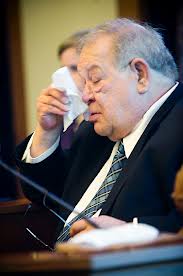 Jerry Trump, a janitor at the Tribune, was with Shawna Ornt when they saw two figures at the crime scene the night of the murder. During the 911 call, Trump could not provide a description of either person.
Jerry Trump, a janitor at the Tribune, was with Shawna Ornt when they saw two figures at the crime scene the night of the murder. During the 911 call, Trump could not provide a description of either person.- From Dec 2001 – Dec 2004 Trump was serving time in prison. During Ryan’s 2005 trial, Trump testified that his wife Barbara had sent him a Columbia Tribune newspaper in prison containing Ryan and Chuck’s arrest photographs. After the trial, Barbara denied that she had ever mailed her husband the newspaper.
- At the start of 2003, the police department produced a video for distribution in Missouri’s prisons. This video showed information about the Heitholt murder and offered a reward of $2,500 for anyone with knowledge that might lead police to the perpetrators. At Ryan’s trial, Trump testified that he saw this video in 2003 and the newspaper story in March 2004, but he never said anything to anyone about ‘recognizing’ Ryan or Chuck.
- Trump was released on Dec 13th, 2004 with 2 years of probation remaining. He was summoned to Prosecutor Crane’s office a week later on Dec 21st. It was during this meeting that he suddenly ‘remembered’ seeing Ryan and Chuck in the parking lot.
- At Ryan’s Oct 2005 trial, Jerry Trump confidently pointed Ryan out as the man he saw at the murder scene.
- According to the police, Jerry Trump had “no useful information” the night of the murder, yet at trial, he was asked by Prosecutor Crane if he could point out the person he saw that night. Why wasn’t Shawna Ornt, the ‘sole witness’ and person who helped with the composite on the night of the murder and again in 2003, asked if she could identify the person she saw that night?
- During Ryan’s Hearing in July 2008, Christine Varner, Trump’s branch manager at the job center that helped employ him, testified that Jerry Trump had told her the day after the murder he was unable to see the suspects faces due to a light in his eyes.
- Trump also told two of his parole officers that he could not see the people in the parking lot. These officers then contacted the Prosecution to make them aware of this information.
- We now have 5 people who have signed sworn affidavits stating that Jerry Trump had told each of them that he could not see the faces of the people in the parking lot.
- Trump’s testimony was crucial to the jury’s guilty verdict. On CBS 48 Hours, a juror stated when Trump said he’d seen Ryan, “and pointed him out, that was pretty much all you needed right there”.
- At Ryan's 2012 Habeas Corpus, Trump testified that the first time he saw the newspaper was in Prosecutor Crane’s office on Dec 21st, 2004. This refutes Crane’s statement that he never showed Trump any photo or the newspaper prior to Ryan’s 2005 trial. Trump tearfully confessed the truth. He had committed perjury under pressure from Prosecutor Crane. Trump asked the Ferguson family for forgiveness.
- In October 2012, Judge Green held that, “this Court does not believe that Jerry Trump testified truthfully about his positive identification of Ryan Ferguson”. In other words, Trump’s in-court identification was thrown out.
- The Fundamental Question in Ryan's Trial: Why did Prosecutor Crane choose to ask Jerry Trump if he could identify Ryan in court, rather than ask Shawna Ornt? Check out the answer on The Index page.
Michael Boyd worked under the supervision of victim, Kent Heitholt, at the Columbia Tribune, and was the last person to see his boss alive.
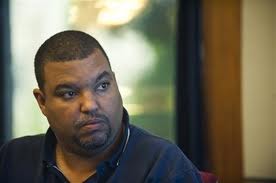 Michael Boyd told detectives he departed the parking lot at 2:20 am just 6 minutes before the 911 call was made. The police and the prosecutor failed to investigate this man, the last person to admit talking to the victim just before his death.
Michael Boyd told detectives he departed the parking lot at 2:20 am just 6 minutes before the 911 call was made. The police and the prosecutor failed to investigate this man, the last person to admit talking to the victim just before his death.- Boyd has changed his story a total of 5 times since the night of the murder (please see the video and '5 Stories of Michael Boyd' document on The Index page)
- Despite all these contradictions and his inability to keep the details of his encounter with the victim minutes before the murder straight, Boyd’s house was never searched, neither car was ever searched, and Boyd was never considered a suspect in the case.
- Attempts to locate Boyd’s Blue Oldsmobile have been unsuccessful. He claims he traded the car in to Enterprise Rent-A-Car in the mid-2000’s, however Enterprise has no record and as late as 2010, the Missouri Dept. of Revenue still has the car titled to him.
- For detailed information on Michael Boyd, please check the Index for Ryan’s 2013 Petition for Writ of Habeas Corpus, specifically page 53.
- When will the State's Attorney ask for Michael Boyd's fingerprints and DNA?
Chuck Erickson had a ‘dream’ that he was involved in the murder of Kent Heitholt.
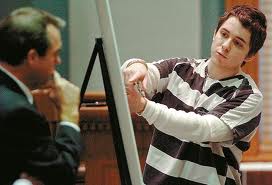 In 2003, The Columbia Tribune published an anniversary story about the unsolved murder of Kent Heitholt. For 2½ years, the police had no significant leads. After reading the article, 19-year-old Chuck Erickson began telling friends he’d had a dream that he may have been involved. A tipster called in and told the police about Chuck’s dreams. Chuck was picked up by the police on March 10, 2004 and taken in for questioning.
In 2003, The Columbia Tribune published an anniversary story about the unsolved murder of Kent Heitholt. For 2½ years, the police had no significant leads. After reading the article, 19-year-old Chuck Erickson began telling friends he’d had a dream that he may have been involved. A tipster called in and told the police about Chuck’s dreams. Chuck was picked up by the police on March 10, 2004 and taken in for questioning.- During his interrogation, Erickson was tentative and unsure at first. He was unaware of any details of the crime that were not made public, telling police he may have dreamed up his entire involvement. Video of the police interrogation shows a confused Erickson struggling to answer police questions about what happened the night of the murder.
- Detective Short asked Erickson if he knew what the victim was strangled with. Chuck demonstrated for Short how he thought Ryan had used his hands. When Short wasn’t satisfied with that Chuck then guessed that maybe a shirt or a bungee cord or maybe even a rope had been used. Short became frustrated and spoon-fed Chuck the information that the victim’s own belt was used. “Really?” said Chuck, “I don’t remember that at all”. Short then asked if it was possible that Ryan had a belt in his hand. Chuck still couldn’t believe the victim was strangled with his own belt and responded, “With the man’s belt? With his own belt?” He was asked if that detail rang a bell, and replied, “not at all”.
- Chuck also said, “I might not even know what I’m talking about.” “I don’t know if I’m just flipping out.” “I’m making presumptions based on what I read in the newspaper.”
- Chuck did not know any details of the crime, because he was not there. The only thing he knew about the murder at the time of his interrogation was what he had read in the Tribune. He did not know when this crime happened, where it happened, or how it happened. Chuck was then spoon-fed confidential information and told by police, “you had better start thinking very clearly because it’s YOU that is on this ‘chopping block’, am I clear to you?”
- Police knew Heitholt was beaten with a blunt object 11 times. After being asked 3 times, Chuck was adamant that he had only hit the victim once. Police told Chuck that the victim had “multiple, multiple, multiple contusions, hits and strikes” to the head. Chuck then said, “I must have done it then”. He also stated he got sick and vomited at the crime scene. No vomit was found at the scene - or any DNA linking Ryan or Chuck to the murder.
- The police proceeded to take Chuck to the crime scene and pointed out the exact location of the murder.
- Chuck took a plea bargain and testified against Ryan. He was given a 25 year sentence for second degree murder.
- Chuck Erickson testified during Ryan's trial that he had been wearing a long-sleeved shirt with a hood, weighed about 150 lbs, had black hair, was 5'6", and was standing at the front of the victims car when he spoke to Shawna Ornt, the cleaning lady. He then claimed he walked around Heitholt's car, towards Ornt, and yelled at her to "Get help, someone is hurt". At this point he testified that he was on the verge of tears, and saw a cord in Ornt's hand.
- During the trial, Shawna Ornt and Jerry Trump testified there was no equipment kept on that level of the Tribune building that required any type of cord. Both said neither one held anything with a cord in their hands at that time.
- During Ryan’s 2008 Hearing, Shawna Ornt testified under oath that she had told Prosecutor Kevin Crane that the person that walked toward her that night - the person she assisted in drawing the composite of - was not Chuck Erickson and was not Ryan Ferguson. (This evidence was withheld from Ryan Ferguson's defense team by Prosecutor Crane)
- She also described the person that spoke to her as: 6 feet tall, 200 lbs, blonde hair, wearing a short-sleeved T-shirt, standing at the rear of the car, calm and composed. (Note: Ryan was 5’8” and 160 lbs at the time)
- Between the arrest and his plea on Oct 1, 2004, Erickson was given "Discovery’" from Prosecutor Kevin Crane. If Chuck had not been given false police reports, he would have had no idea which way the trail led away from the crime scene. This and other details led Chuck to believe he had to have committed the crime. These details included false statements from multiple people who have since stated that the police fabricated their reports. Chuck completely changed his story to match the physical evidence.
-
Once Chuck Erickson read the fabricated police reports of witnesses, that were supplied to him by Prosecutor Crane, and considering the prosecutor's media statement in reference to capital punishment, Erickson started the process of considering taking a plea and testifying against Ryan Ferguson to save his life or minimize his prison time. From this point on Erickson was committed to say and do anything to save himself.
-
On the day of his arrest, after the police showed Erickson where the crime happened, Erickson showed detectives where he thought he ran after leaving the parking lot (crime scene). Erickson showed them the intersection of Providence and Ash. It would have taken him about 5 seconds to get there. He told them he saw a friend, Dallas Mallory, stopped in the southbound lane in the company of two girls. After a short conversation, Erickson said Mallory drove off continuing south while Erickson and Ryan returned to the By George Night Club.
-
The discovery showed a K-9 dog (Police Report #42) followed the ‘hot’ trail from the crime scene south to Broadway and beyond to the Diner, and south to the University campus. Yet Erickson testified he turned west at the Diner towards Flat Branch Park and on to Providence. This is Erickson's second story post Discovery. Erickson also said he saw Dallas Mallory in his car stopped at a red light at a different intersection, 4 blocks south from the first story. Erickson testified he saw Dallas Mallory within 5 seconds of the crime (his first story) which can be seen on video and later said he saw Mallory four blocks south stopped at a red traffic light (his second story)
-
Chuck stated in his affidavit, that he took the plea against Ryan because he thought Ryan was going to plea first, based on the fabricated police reports he had read. Prosecutor Crane misled Chuck into thinking Ryan was going to plea and leave him with the longer prison sentence and possibly the death penalty. Charles and his family panicked and went with the plea on October 1, 2004.
-
Chuck has now been shown follow up interviews with these false witnesses and realizes that Ryan was not going to plea and was not saying anything about being guilty. It had all been a ploy by the prosecutor to help convince Chuck to plea against Ryan.
-
Prosecutor Crane said to the jury during the first day of the trial in his opening statement that there was not one piece of evidence found at the crime scene connecting Ryan or Chuck to the crime.
-
In April 2012, at Ryan’s habeas corpus, Erickson admitted he committed perjury at trial and is unable to remember the events of that night.
Ryan was arrested in March 2004 at the age of 19. He has been behind bars ever since, despite his clear innocence.
 Ryan had never met victim Kent Heitholt and had no history of criminal behavior.
Ryan had never met victim Kent Heitholt and had no history of criminal behavior.- Ryan said he left the By George bar with Chuck Erickson at around 1:15 am the night of Heitholt’s murder. He drove Chuck home and then made some calls on his cell phone while sitting on the curb outside his home prior to going to bed.
- Ryan’s phone records show he was on the phone continuously from 1:41 am to 2:09 am.
- Ryan was the victim of shocking pre-trial prejudice from the Missouri justice system. His bail was set at $20 million – the highest bail EVER set in US history for ANY murder. Boone County had previously never set a bail higher than $1 million.
- Ryan’s trial lasted just 5 days. The jury deliberated for just a few hours before handing down a guilty verdict – late on a Friday afternoon.
- Ryan is currently serving a 40-YEAR sentence. He will not be eligible for parole until 2040.
- Several jury members who served at Ryan's 2005 trial have expressed their thoughts on Ryan's conviction and believe he deserves a new trial in light of the lies which were conveyed to them by the Prosecutor and his witnesses.
- Ryan has also taken a fully polygraph test and passed it.
Chuck Erickson initially testified that he spoke to Dallas Mallory a few minutes after Kent Heitholt's murder. Erickson said Mallory was stopped at a red light at the intersection of Providence and Ash.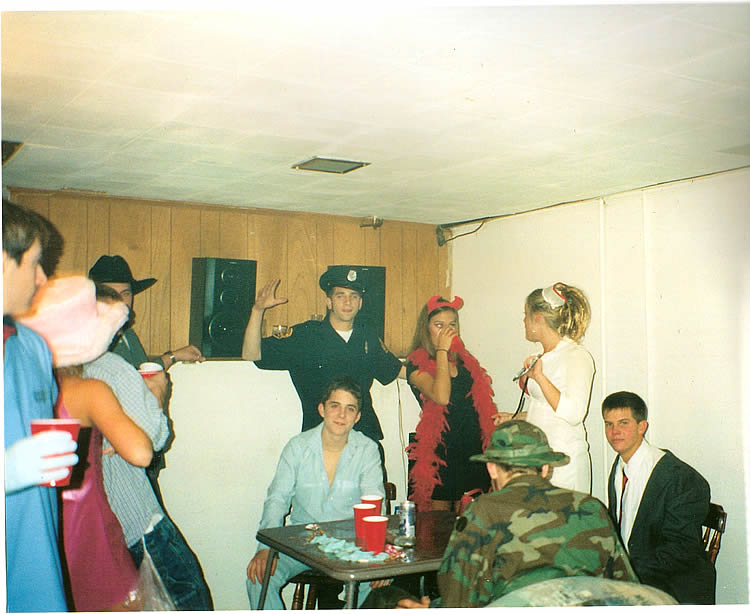
- 7 months later, after receiving the discovery reports, Erickson changed his story to say he had seen Dallas at Providence and Locust heading south in a car with two girls as passengers.
- Erickson was able to tell police what Dallas was wearing that night – “a police uniform”. Once the police confirmed this was true they were convinced Dallas must have been at the intersection just as Erickson had told them.
- Later, a photo was found showing Chuck and Dallas together at a party approximately five hours prior to the murder. In this photograph Chuck is sitting in a chair with Dallas standing behind him in full police uniform. This is how Erickson knew what Dallas Mallory had been wearing that night. Erickson had seen him at a party earlier that night, not downtown at either intersection as he had stated.
- Mallory wrote a sworn affidavit in December 2004, before Ryan's trial, stating he did not see or talk to Chuck or Ryan downtown that night. However Mallory was not called to testify. Prosecutor Crane did not call Mallory because he already knew he would say that he never saw Chuck downtown after the murder. The jury never heard Mallory’s testimony.
- In July 2008, Dallas finally had the opportunity to testify in Ryan’s Hearing. Dallas said he never saw or spoke to Chuck or Ryan downtown that night. He stated he did not own a car and did not have a driver’s license at the time.
- Dallas also testified that the police yelled at him and threatened to charge him if he didn’t cooperate and say what they wanted to hear, screaming at him and claiming that he knew info and wasn’t telling the truth.
- After the police told Mallory that Erickson claimed to have seen him after the murder, Dallas told them that Chuck must have seen him, but he did not see Chuck. He testified he was scared and panicked and just told them what they wanted to hear so they would let him go.
- Dallas could not have been stopped at a red light at this intersection because in a sworn affidavit from the Missouri Department of Transportation we now know that these lights cycle each day until 1:00 am, at which time the Providence traffic lights switch to a flashing yellow. There would be no reason to stop at a flashing yellow light at 2:30 am, especially with police swarming the area.
- The two girls who were allegedly with Dallas have never been found or named. Nor have the police ever accounted for the car Dallas was allegedly driving that night.
At trial, Chuck Erickson testified that after the murder and after seeing and talking to Dallas Mallory, he and Ryan went back to the By George nightclub around 2:45 am.
- Erickson testified he got into the club through the same bouncer (Mike Schook) that had let them in earlier in the night.
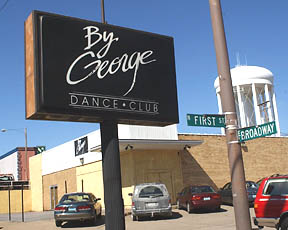
- Erickson testified that he and Ryan returned to the club without any money, despite the ‘robbery’ he claimed they had both taken part in.
- Chuck claimed the music was loud and people were drinking and dancing. He testified that a police officer stood beside a patrol car in the parking lot adjacent bar preventing he and Ryan from leaving the club for 1-2 hours (This would have then made the time around 4.00-4.30am). He said that when they left the club, the streets were crowded with cars and people.
- Police records show that there was not an officer at that location at that time on that night. No witnesses have ever been found who support this story of Chuck’s.
- Bouncer Mike Schook testified for the first time at Ryan’s July 2008 Hearing. He said he was NEVER present at the club after 2:15 am.
- Schook testified the club always closed at 1:30 am and the doors were always locked at that time. In the club’s 10-year history they had never received a summons for being open after hours.
- Kim Bennett was also at the bar that night and signed a sworn affidavit stating that she and her friend saw Chuck and Ryan leave the bar between 1:15 and 1:30 am, get into Ryan’s car and drive off – just as Ryan has always maintained.
- However the jury at Ryan’s 2005 trial NEVER heard Kim’s evidence. Her statement was deliberately withheld from Ryan’s defense team. She never got the chance to testify during the trial but did finally testify during Ryan's 2012 habeas hearing.
- There were at least 10 other high school friends of Ryan and Chuck at the bar that night. All agree that the pair could have borrowed money from any of them and had no reason to leave the bar, let alone commit a robbery.
A key figure in the investigation, prosecution and imprisonment of Ryan Ferguson was Prosecutor Kevin Crane.
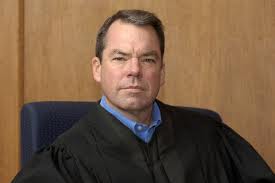 Under the leadership of Crane, the Columbia police department and Boone County Prosecutor's Office committed numerous legal violations against Ryan.
Under the leadership of Crane, the Columbia police department and Boone County Prosecutor's Office committed numerous legal violations against Ryan.- Witness statements changed constantly throughout the police investigation – often mere hours after they were first recorded - and Chuck Erickson was fed information about the murder that was not yet known to the public.
- Prosecutors are also legally required to pass on any information to the defense team that may assist them – but the crucial evidence of Shawna Ornt and Kim Bennett among others was never passed on to Ryan’s defense team.
- Jerry Trump testified in 2012 that Kevin Crane aided and abetted in his 2005 false testimony. Crane told Trump his altered identification ‘would be helpful’ to his case.
- Meanwhile Dallas Mallory and Shawna Ornt stated that investigating officers shouted and threatened them when they wouldn’t change their statements that they hadn't seen Ferguson or Erickson at or near the crime scene.
- At the time of Ryan’s arrest Kevin Crane was an ambitious DA seeking to become a judge. Ryan was sentenced to 40 years in prison for a crime he did not commit, Crane became a Boone County Judge, taking over the seat vacated by Ryan’s trial judge, Ellen Roper.
Ryan was granted a habeas corpus hearing in April 2012, overseen by Ryan’s new lawyer Kathleen Zellner.
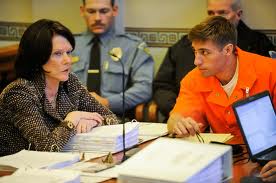 At this hearing Jerry Trump dramatically admitted he had lied under oath, under pressure from Prosecutor Kevin Crane.
At this hearing Jerry Trump dramatically admitted he had lied under oath, under pressure from Prosecutor Kevin Crane.- Trump said he hadn’t seen Ryan at the murder scene but had been coerced by Crane who said ‘it would be helpful’ to his case to change his testimony.
- On the stand Trump tearfully asked for forgiveness from Ryan and the Ferguson family.
- Chuck Erickson also gave evidence at this hearing, admitting that he could not remember any details of the night in question and had lied at the original trial.
- Judge Green waited just over 6 months to deliver his judgment – cruelly withholding his ruling until Oct 31st 2012 – the 11-year anniversary of Kent Heitholt’s murder.
- Green held that Trump had in fact lied when he identified Ryan at trial. Yet Green inexplicably held that Trump’s false identification was not a difference-maker at Ryan's trial. However, in TV interviews jurors indicated that Trump’s identification was in fact crucial to their verdict.
- Equally as puzzling was Green’s finding that Erickson’s trial testimony was credible, despite a prior appellate court’s holding to the contrary and the mountains of evidence of coercion and factual inconsistencies.
- Judge Green's decision was appealed to the Western District Appellate Court on Jan 30, 2013.
The Free Ryan Ferguson campaign has now become an international movement, gaining strength by the day. We are determined to see Ryan walk free as soon as possible.
- Several original jury members who served at Ryan’s 2005 trial now think he deserves a new trial in light of lies which were conveyed to them by the prosecutor and his witnesses.
- NBC’s Dateline and CBS’s 48 Hours continue to provide valuable coverage of Ryan’s case. CBS correspondent Erin Moriarty has personally stated she wants to see Ryan ‘walk out of prison.’
- The Free Ryan Ferguson Facebook page, set up by a senior member of the Facebook team, has already attracted tens of thousands of followers.
- Ryan’s Change.org petition has also attracted thousands of signatures.
- But Ryan needs YOUR help – now.
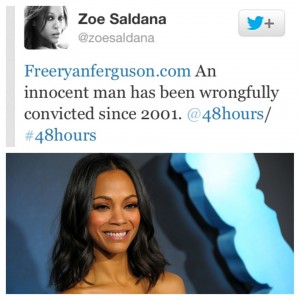

 A single strand of bloody hair was found in the hand of the victim Kent Heitholt. It did not match Ryan Ferguson, Chuck Erickson or Heitholt.
A single strand of bloody hair was found in the hand of the victim Kent Heitholt. It did not match Ryan Ferguson, Chuck Erickson or Heitholt.
 Jerry Trump, a janitor at the Tribune, was with Shawna Ornt when they saw two figures at the crime scene the night of the murder. During the 911 call, Trump could not provide a description of either person.
Jerry Trump, a janitor at the Tribune, was with Shawna Ornt when they saw two figures at the crime scene the night of the murder. During the 911 call, Trump could not provide a description of either person. Michael Boyd told detectives he departed the parking lot at 2:20 am just 6 minutes before the 911 call was made. The police and the prosecutor failed to investigate this man, the last person to admit talking to the victim just before his death.
Michael Boyd told detectives he departed the parking lot at 2:20 am just 6 minutes before the 911 call was made. The police and the prosecutor failed to investigate this man, the last person to admit talking to the victim just before his death. In 2003, The Columbia Tribune published an anniversary story about the unsolved murder of Kent Heitholt. For 2½ years, the police had no significant leads. After reading the article, 19-year-old Chuck Erickson began telling friends he’d had a dream that he may have been involved. A tipster called in and told the police about Chuck’s dreams. Chuck was picked up by the police on March 10, 2004 and taken in for questioning.
In 2003, The Columbia Tribune published an anniversary story about the unsolved murder of Kent Heitholt. For 2½ years, the police had no significant leads. After reading the article, 19-year-old Chuck Erickson began telling friends he’d had a dream that he may have been involved. A tipster called in and told the police about Chuck’s dreams. Chuck was picked up by the police on March 10, 2004 and taken in for questioning. Ryan had never met victim Kent Heitholt and had no history of criminal behavior.
Ryan had never met victim Kent Heitholt and had no history of criminal behavior.

 Under the leadership of Crane, the Columbia police department and Boone County Prosecutor's Office committed numerous legal violations against Ryan.
Under the leadership of Crane, the Columbia police department and Boone County Prosecutor's Office committed numerous legal violations against Ryan. At this hearing Jerry Trump dramatically admitted he had lied under oath, under pressure from Prosecutor Kevin Crane.
At this hearing Jerry Trump dramatically admitted he had lied under oath, under pressure from Prosecutor Kevin Crane.

